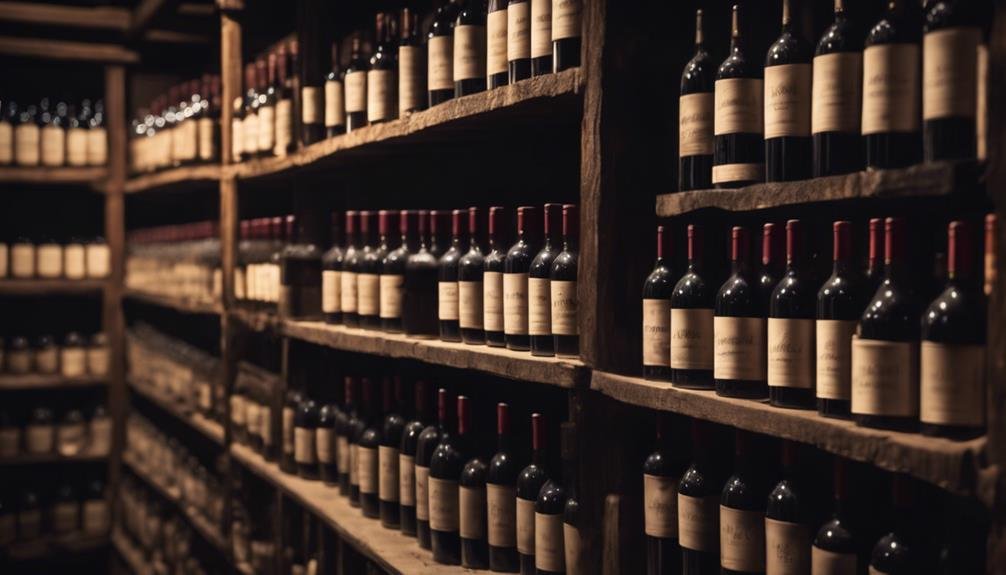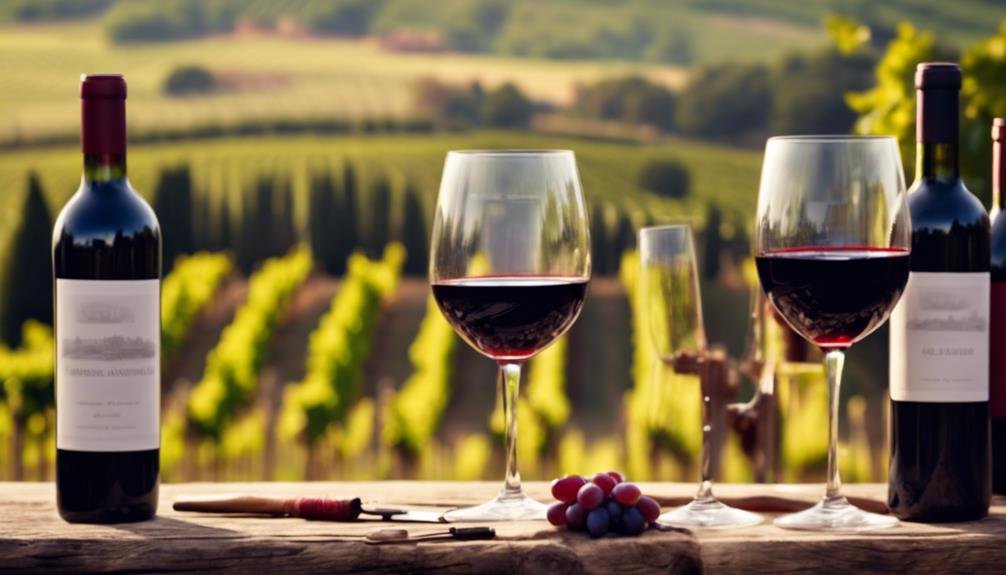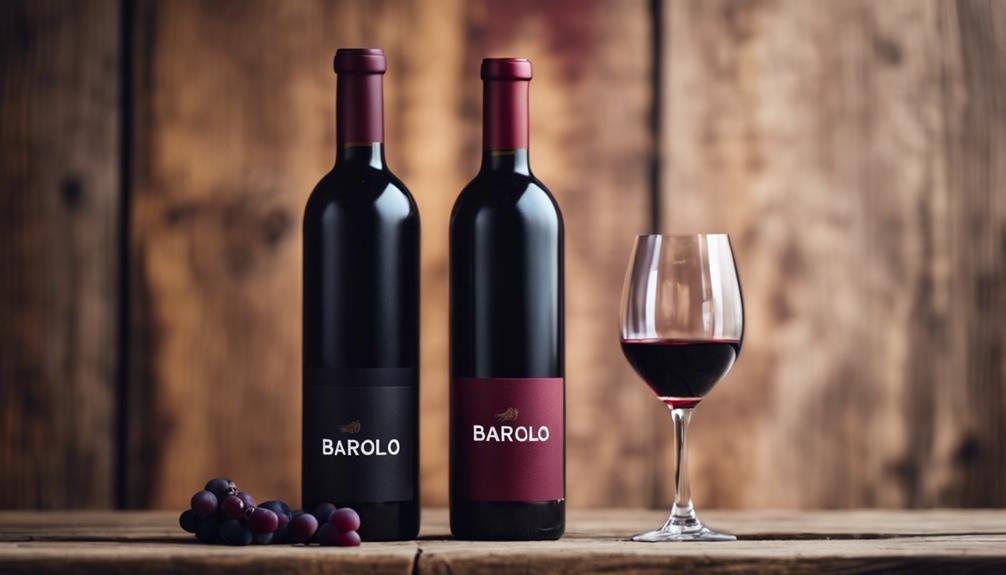In Italy's wine world, Barolo and Brunello stand tall, showcasing Nebbiolo and Sangiovese grapes, each with distinct tannin levels and flavor profiles. Barolo delights with rose petal, cherry, and white pepper notes, ideal with game birds and truffle risotto. Meanwhile, Brunello entices with sour cherry, oregano, and balsamic hints, paired perfectly with rich red meats and Tuscan cuisine. Both age beautifully, with Barolo peaking in 10-25 years and Brunello shining after similar aging. For those intrigued by these wine powerhouses, exploring alternatives like Barbaresco and Vino Nobile di Montepulciano can further enrich the palate experience.
Barolo Vs Brunello: a Comparative Overview
In the world of Italian wine, the comparison between Barolo and Brunello emerges as a focal point for discerning wine enthusiasts seeking distinctive expressions of Nebbiolo and Sangiovese grapes from Piedmont and Tuscany, respectively.
Nebbiolo, the grape behind Barolo, offers high tannins with tasting notes of rose petal, cherry, and white pepper, reflecting the terroir influence of Piedmont. In contrast, Brunello, crafted from Sangiovese grapes, showcases moderate tannins and flavors like sour cherry, oregano, and balsamic, influenced by Tuscany's unique terroir.
These regional differences in terroir play a significant role in shaping the flavor profiles of these revered Italian wines, providing wine enthusiasts with a diverse range of options to explore and savor.
Flavor Profiles of Barolo and Brunello
The distinct flavor profiles of Barolo and Brunello wines offer wine enthusiasts a compelling journey through the unique terroirs of Piedmont and Tuscany. Tasting notes reveal that Barolo presents a robust combination of rose petal, cherry, raspberry, cinnamon, and white pepper, providing a complex and intense experience.
In contrast, Brunello showcases tasting notes of sour cherry, oregano, balsamic, red pepper flake, and brick, offering a more nuanced and earthy flavor profile. Aroma comparison shows Barolo with a floral and spicy bouquet, while Brunello leans towards herbal and savory aromas.
These distinct characteristics stem from the different grape varieties, Nebbiolo for Barolo and Sangiovese for Brunello, as well as the diverse climates and soils of Piedmont and Tuscany.
Aging and Drinking Recommendations

Comparing the aging and drinking recommendations for Barolo and Brunello wines provides valuable insights into maximizing the enjoyment of these distinguished Italian reds. Barolo's best vintages typically require aging for 10-25 years, with the wine reaching its peak after a decade. For those who prefer aged wines, selecting a Barolo Riserva and cellaring it for around 5 years is advised.
Similarly, Brunello wines are best enjoyed after aging for 10-25 years, with the ideal drinking window beginning after a decade. Opting for a Brunello Riserva and allowing it to mature for 6 years can enhance the experience. When considering cellar selection, seeking out the top vintages for both Barolo and Brunello ensures a rewarding tasting experience.
Food Pairing Suggestions for Barolo and Brunello
Food Pairing Recommendations for Barolo and Brunello wines offer delightful culinary experiences that elevate the enjoyment of these distinguished Italian reds. When considering food pairings for Barolo, think of dishes that can stand up to its intense tannins. Game birds, veal, porcini, and truffle risotto are excellent choices that complement the wine's bold flavors. On the other hand, Brunello pairs well with richly flavored red meats, tomato-based dishes, and Tuscan fare, enhancing the overall dining experience. For a more detailed guide, refer to the table below:
| Barolo Pairing | Brunello Pairing |
|---|---|
| Truffle pairing | Tuscan cuisine |
| Meaty dishes | Flavor contrasts |
Exploring Alternatives to Barolo and Brunello

Exploring alternative wine options that offer distinct characteristics and regional nuances can broaden one's appreciation for Italian reds beyond the traditional Barolo and Brunello varieties. For those seeking alternatives to Barolo, Barbaresco presents a compelling option, sharing similarities but showcasing its unique terroir from the neighboring region.
Nebbiolo Langhe, a declassified Barolo from Piedmont, offers a more accessible entry point into the world of Nebbiolo wines. On the other hand, those looking beyond Brunello could explore Vino Nobile di Montepulciano, a great Sangiovese wine hailing from a nearby town. Rosso di Montalcino, with lower aging requirements than Brunello, provides a glimpse into the Sangiovese grape's versatility.
Each of these alternatives brings its own charm and flavor profile to the table, enriching the Italian wine experience.
Frequently Asked Questions
Can Barolo or Brunello Be Served Chilled?
Barolo and Brunello should not typically be served chilled, as their complex flavors and aromas are best appreciated at slightly warmer temperatures. Serving these wines at around 60-65°F enhances their characteristics, making them ideal companions for rich, flavorful dishes.
Are There Organic or Biodynamic Options Available?
In the domain of Italian wines, consumers can find organic and biodynamic options that showcase sustainable practices and natural winemaking. These certifications guarantee environmentally friendly production methods, enhancing the quality and authenticity of the wine.
Do Barolo and Brunello Wines Contain Sulfites?
Sulfites are a common preservative in wines like Barolo and Brunello. While they can trigger allergies in some individuals, the amounts typically present are generally safe. The health benefits of moderate wine consumption may outweigh allergen concerns for many consumers.
Are There Specific Glassware Recommendations for These Wines?
For enjoying the nuances in Barolo and Brunello wines, consider specific glassware preferences. Opt for large-bowled glasses to allow aeration and capture aromas effectively. Serve Barolo between 60-65°F and Brunello between 59-64°F for the best tasting experience.
Can Barolo or Brunello Be Used in Cooking?
Barolo and Brunello can enhance various dishes when used in cooking. Barolo's intense tannins complement rich meats, while Brunello's flavors enrich red meat and tomato-based dishes. Incorporate these wines for elevated flavors in recipes.
Conclusion
In the world of Italian wines, Barolo and Brunello stand out as formidable contenders, each with its own unique characteristics and complexities. As age-worthy wines, they demand patience and precision in their aging process to reveal their full potential.
From the high-tannin profile of Barolo to the moderate tannin structure of Brunello, these wines offer a sensory journey that captivates enthusiasts worldwide. Whether you prefer the boldness of Barolo or the elegance of Brunello, both wines showcase the rich diversity and excellence of Italian winemaking.
